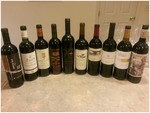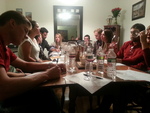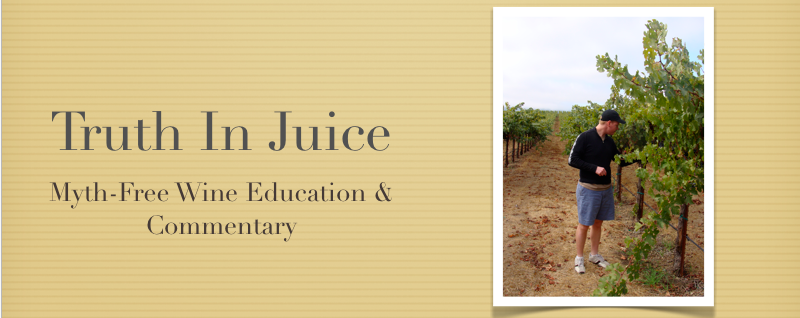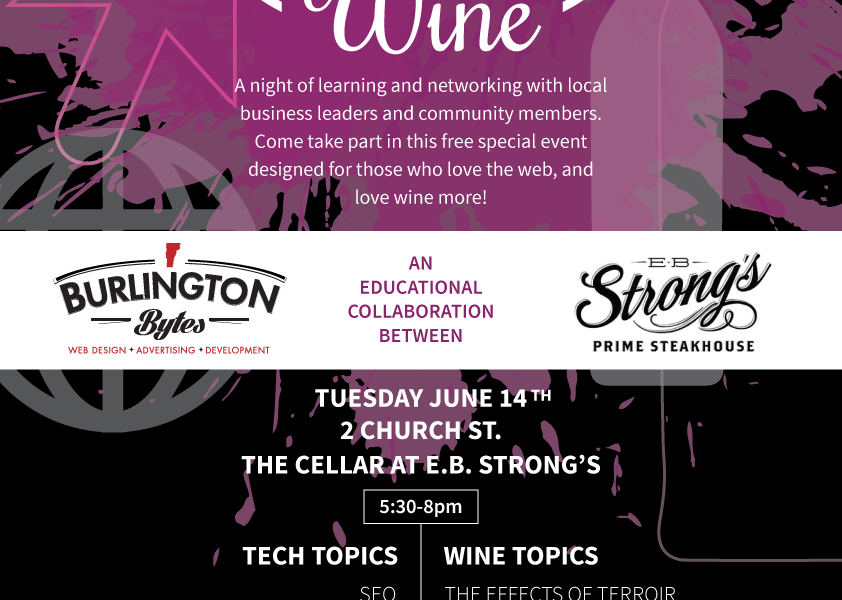"Just Give Me a Glass of Cab..." - Cabernet Panel Tasting Results
 Sunday, September 30, 2012 at 11:42PM
Sunday, September 30, 2012 at 11:42PM "Just give me a glass of Cab." Our tasting line-up
Our tasting line-up
Those words have probably been uttered thousands of times, by bar patrons, wedding attendees, and countless other wine drinkers looking for a simple and appealing glass of red. Cabernet Sauvignon is one of the world's most widely planted grapes, having migrated from its ancestral home in Bordeaux's Medoc peninsula to play a leading role in wine production on nearly every continent in which grapes are grown. It originated as the product of an accidental crossing between Sauvignon Blanc and Cabernet Franc, but once consumers fell in love with the grape, there was no holding it back. Today, Cabernet Sauvignon can be found in France, the United States, Italy, Australia, South Africa, Chile, Argentina, Spain, Canada and more. While the styles of the wines produced from Cabernet Sauvignon depending on the country in which it is produced, the fact of the matter is that Cabernet Sauvignon resonates with consumer's palates in a manner that few other grapes are able to replicate. The term "Cab" or "Cabernet Sauvignon" is often used as a synonym for red wine by novice wine drinkers. Due to its near univeral popularity, Cabernet Sauvignon has seen its name become genericized, in much the same way that a "Coke" has become something of a generic term for a soda, or soft drink.
When I learned that August 30th was Cabernet Day, and planned a panel tasting to celebrate the event, I didn't anticipate any trouble finding enough panelists to fill the spaces at the table. I was certain that Cabernet Sauvignon's popularity would prove to be a sufficient draw. I was half right. I forgot that if there is anything that can undermine the popularity of a grape like Cabernet Sauvignon, it is the allure of traveling on a holiday weekend. Given that August 30th fell on the Thursday before Labor Day holiday, travel plans made it difficult to recruit a sufficient number of panelists, and so we rescheduled the tasting for September 20th. On the date of the rescheduled tasting, my hypothesis about the allure of Cabernet Sauvignon proved correct. I had requests to join the tasting panel coming into my inbox until 2 hours before the event. Ultimately, we had 14 panelists for the event, representing a mix of wine lovers, ranging casual wine drinkers, to tasting room associates, and wine shop owners.
Given the broad spectrum of Cabernet Sauvignon that exists in the market place, I recognized that showcasing a representative sample of the grape would be a difficult task. One of the interesting byproducts of popularity is that there are various incarnations of Cabernet Sauvignon, which vary both in terms of their native geography, and in the style in which they are produced. High end Cabernet Sauvignons are typically made to be aged, and can take years to show their desired character. The high levels of tannin in the grape, combined with the tannin imparted by the oak can cause some Cabernet Sauvignons to be very tight and astringent in their youth, before evolving to show off a well integrated mix of fruit, herb and spice flavors, and a rich, silky, texture. Expensive, well-made Cabernet Sauvignons, such as Chateau Latour, Chateau Lafite, and other top Medoc Bordeaux, are capable of aging for 20 years or more. Many "cult" California Cabernets (e.g. Harlan Estate, Screaming Eagle, Bryant Family, Scarecrow, etc.) are constructed in much the same way, that is, they are made with the intention that they will be aged. Given that opening the above mentioned wines in their youth is tantamount to infanticide, and that their price tags are well beyond the realm of affordability for most consumers, I decided to focus on more affordable wines that would be more approachable in their youth.
Our tasting consisted of 10 wines, which ranged in price from $10.99 to $33.99 per bottle. The wines were purchased from three retail shops in the Burlington, Vermont area: Burlington Wine Shop, Village Wine & Coffee, and Cheese Traders. Four of the wines were from California, three were from the Medoc in Bordeaux (Margaux, Graves, and Haut-Medoc were the appelations represented), two were from Argentina, and one wine was from Australia. To the extent possible, I tried to ensure that all the wines were from the 2009 vintage, which was a very good vintage in California, and an exceptional vintage for the Medoc region of Bordeaux. The two Argentine wines featured in the tasting were from the 2007 and 2008 vintage, respectively. However, the goal of the tasting was to assess the current state of Cabernet Sauvignon, and whether the wines available to everyday consumers justify its lofty reputation. To that end, I felt compelled to include a broad spectrum of the Cabernet Sauvignons available, even if a few were not from the 2009 vintage.
I faced a similar problem when looking for Bordeaux wines to include, as the wines of Bordeaux are subject to different regulations than the Cabernet Sauvignons of the United States, Argentina and Australia. In the United States, if a varietal is listed on the label, at least 75% of the wine in the bottle must come from that grape. In Argentina, the threshold is 80%, and in Australia it is 85%. However, given that France espouses the concept of terroir, which emphasizes the importance of where the grapes are grown, instead of the type of grape varietal, the Bordeaux wines included in the tasting had significantly lower percentages of Cabernet Sauvignon than their new world counterparts.
At the tasting, the panel was presented with ten Cabernet Sauvignons, which were tasted one at a time, in succession, over a period of two hours. Despite the fact that our wines were on the less expensive end of the spectrum, and generally considered ready to drink, 2009 is still a relatively young vintage, and consequently, I aerated each of the wines 2 hours prior to the tasting. I opened each bottle, poured the wine into a decanter, and then poured it back into the bottle. All of the wines were tasted blind, the panelists were only told that they were tasting Cabernet Sauvignon from a mix of countries, mostly from the 2009 vintage. The price range of the wines was mentioned prior to the tasting, but there was no mention of the prices of specific wines. The wines were presented to the tasting panel in the following order:
2009 Michel Schlumberger "La Cime" Cabernet Sauvignon, Dry Creek Valley, California - $19.99
2009 Chateau Aney, Haut-Médoc, Bordeaux - $24.99
(65% Cabernet Sauvignon, 25% Merlot, 7% Cabernet Franc, 3% Petit Verdot)
2009 Chateau de la Coste, Margaux, Bordeaux - $34.99
(50% Cabernet Sauvignon, 45% Merlot, 5% Cabernet Franc)
2009 Cameron Hughes "Lot 300" Cabernet Sauvignon, Napa Valley - $26.99
2009 Banshee Cabernet Sauvignon, Napa Valley - $29.99
2007 Essencias de la Tierra Cabernet Sauvignon, Mendoza, Argentina - $10.99
2009 Sean Minor Cabernet Sauvignon, Napa Valley - $18.99
2009 Chateau de Chantegrive, Graves, Bordeaux - $24.99
(50% Cabernet Sauvignon, 50% Merlot)
2008 90+ Cellars "Lot 53" Cabernet Sauvignon, Mendoza, Argentina - $13.99
2009 First Drop Wines "Mother's Ruin" Cabernet Sauvignon, McLaren Vale, Australia - $15.99
The wines were overwhelmingly well received by the tasting panel. Prior to the tasting, the panelists were surveyed, and the majority of the panelists reported that they liked Cabernet Sauvignon equally as well as other wines. After the panel, opinions were largely unchanged, as panelists rated the overall quality of the wines presented as an 8 out of 10 (responses from all panelists were averaged). Nearly every wine received at least one first, second, or third place vote. Still, it was interesting to see the variation in the specific preferences among the tasting panelists, which varied according to geography.
Our top two wines, the 2009 Banshee Cabernet Sauvignon and the 2009 Sean Minor Cabernet Sauvignon both hailed from California's Napa Valley. Both wines were tremendously approachable, with soft tannins, and supple fruit flavors. The Banshee was the overwhelming favorite among the group, receiving five first-place votes, and four second-place votes. It was plush and jammy, with dark fruit flavors, such as currant and cassis. It was generally big and bold, but it displayed nuanced flavors of tobacco, and dried herbs on the finish, and its oak was well integrated. On the opposite end of the spectrum, our number-two wine, the Sean Minor Cabernet Sauvignon, was much more restrained, displaying a silky, elegant character that some panelists described as sexy. Soft berry fruit flavors were followed by subtle hints of chocolate on the finish. It received two first-place votes, one second-place vote, and four third-place votes. Its lighter bodied, more elegant character really seemed to resonate with the group, but it still presented as far more plush and approachable than any of the Bordeaux in the tasting.
 The Tasting PanelNo Bordeaux wines cracked the top three when the results of the tasting were tallied, but there was an obvious affinity for Bordelais wines demonstrated by some members of the tasting panel. The Chateau de la Coste, from Margaux, finished tied for fourth-place, but it received more first-place votes than any wine in the tasting, except for the Banshee. Yet, in a curious twist, the three third place votes were the only votes it received. Those that loved the Chateau de la Coste commented on its gorgeous nose of fresh ground coffee and tobacco, and elegance on the palate that one panelist described as "ballerina-like." On the palate, tasters appreciated its berry flavors and notes of vanilla. I was tremendously impressed by the nose of the Chateau de la Coste. The ground coffee flavors were exceptionally pronounced, and there was an almost port-like quality to its aromas. Yet after experiencing the bold, concentrated flavors on the nose, I found myself disappointed by how lean the wine was on the palate. This was a sentiment that was echoed by other tasters, who stated that the wine seemed to die on the palate. Appreciation for the lean, elegant character displayed by the Bordeaux wines versus a desire for the palate to live up to the wine's bold vibrant aromas was a central point of debate among the tasting panel. The dichotomy was also exhibited in the Chateau Aney and the Chateau de Chantegrive. The Chateau Aney showed notes of menthol and coffee, and the Chateau de Chantegrive demonstrated intense notes of baking chocolate, but seemed lean and subdued on the palate, after experiencing their tantalizing aromas. It was almost like watching an extremely intruiging movie trailer, and then being disappointed by the full movie. I imagine that the palate will become more integrated with a few years of bottle age, and I would certainly look forward to trying these wines again further down the road. While there were some who appreciated the restraint that these wines exhibited, I would side with the half that wished that the Bordeauxs were more expressive on the palate, as I expect them to be in a few years.
The Tasting PanelNo Bordeaux wines cracked the top three when the results of the tasting were tallied, but there was an obvious affinity for Bordelais wines demonstrated by some members of the tasting panel. The Chateau de la Coste, from Margaux, finished tied for fourth-place, but it received more first-place votes than any wine in the tasting, except for the Banshee. Yet, in a curious twist, the three third place votes were the only votes it received. Those that loved the Chateau de la Coste commented on its gorgeous nose of fresh ground coffee and tobacco, and elegance on the palate that one panelist described as "ballerina-like." On the palate, tasters appreciated its berry flavors and notes of vanilla. I was tremendously impressed by the nose of the Chateau de la Coste. The ground coffee flavors were exceptionally pronounced, and there was an almost port-like quality to its aromas. Yet after experiencing the bold, concentrated flavors on the nose, I found myself disappointed by how lean the wine was on the palate. This was a sentiment that was echoed by other tasters, who stated that the wine seemed to die on the palate. Appreciation for the lean, elegant character displayed by the Bordeaux wines versus a desire for the palate to live up to the wine's bold vibrant aromas was a central point of debate among the tasting panel. The dichotomy was also exhibited in the Chateau Aney and the Chateau de Chantegrive. The Chateau Aney showed notes of menthol and coffee, and the Chateau de Chantegrive demonstrated intense notes of baking chocolate, but seemed lean and subdued on the palate, after experiencing their tantalizing aromas. It was almost like watching an extremely intruiging movie trailer, and then being disappointed by the full movie. I imagine that the palate will become more integrated with a few years of bottle age, and I would certainly look forward to trying these wines again further down the road. While there were some who appreciated the restraint that these wines exhibited, I would side with the half that wished that the Bordeauxs were more expressive on the palate, as I expect them to be in a few years.
Although the disparity between the preference for Bordeaux versus California was a theme, I found myself even more intrigued by the prejudice against wines from the Southern Hemisphere that seemed to be held by many of the panelists. Time and again, as we tasted the wines, I overheard tasters dismissing wines that did not suit their tastes as likely to be from South America or Argentina. On one occasion, I heard a panelist exclaim, "I just don't think Argentina is capable of making quality Cabernet."
Prior to the 1976 "Paris Tasting," French wines were regarded with a certain mystique by most wine consumers. Wines were made in other countries, by they were largely deemed inferior to the wines of France. In an earlier column on the 1976 "Paris Tasting," I commented on how striking it was to observe the limited availability of wines from countries outside of France (and Bordeaux and Burgundy in particular) in an early 1970s wine catalogue. Regions such as California, Spain, Italy, France's Rhone Valley, and Alsace were confined to the back end of the catalogue, while other regions such as Oregon, New Zealand and South America were left out entirely. The 1976 "Paris Tasting" was significant because when French judges announced the 1973 Chateau Montelena Chardonnay as the top white in the tasting, followed by the announcement of the 1973 Stag’s Leap Wine Cellars S.L.V. Cabernet Sauvignon as the top red, it gave the American wines a sweep of the event, and opened the door for the globalization of the wine trade. However, during our tasting, there still seemed to be a sense of geographic prejudice.
In an ironic twist, our number-three wine, and our best value, hailed from Mendoza, Argentina. The 2008 90+ Cellars "Lot 53" Cabernet Sauvignon, garnered one first-place vote, two second-place votes, and three third-place votes. Panelists loved its jammy character, with dark fruit flavors, and well-integrated notes of vanilla and oak. It was tremendously concentrated, and at $13.99, represented an incredible value. Strangely though, many panelists assumed it was from California when they tasted it. Admittedly, California has a more lengthy history of wine production, compared to South American countries, but the wines of Argentina and Chile have certainly gained international respect over the past several years. Argentina's reputation is largely associated with Malbec, but the country has produced 118 Cabernet Sauvignons that have been rated 90 points or higher in Robert Parker's The Wine Advocate. In addition to the 90+ Cellars "Lot 53" Cabernet Sauvignon, the other wines from the Southern Hemisphere that were showcased in the tasting were well received by the tasting panel. They did not score in the top three, but the panel appreciated the dried fruit and sour cherry notes of the 2007 Essencias de la Tierra Cabernet Sauvignon (from Mendoza, Argentina), as well as the notes of violet and honey crisp apple, and honeyed red fruit flavors in the 2009 First Drop Wines "Mother's Ruin" Cabernet Sauvignon (from McLaren Vale, Australia). The assumption that France and California would produce the only worthwhile wines in the tasting was disproved at the end of the night, as the wines from the Southern Hemisphere acquitted themselves well, and showed that Cabernet Sauvignon can achieve greatness in virtually all corners of the world.
Perhaps a side product of Cabernet Sauvignon's global expansion is the rise of negociant produced wines in geographies outside of France. Negociant producers are those that buy grapes or finished wines from vineyard owners or wineries, and then bottle the product under their own label. France has long been known for its use of negociant producers in regions such as Burgundy, as many grape growers do not have sufficient grape production to profitably grow their own wines. Over the past few years, the worldwide recession, and a global wine glut have combined to create a situation in which many high end wines have gone unsold. This has lead to a rise of negociant producers in the US market, such as 90+ Cellars, Cameron Hughes, and Banshee. All of these producers employ different strategies for sourcing their wines, but all of the wines showed well in our tasting. Lettie Teague wrote an excellent article on Cameron Hughes wines a couple of years ago. While the 2009 Cameron Hughes "Lot 300" Cabernet Sauvignon did not finish as a top three wine in our tasting, it did tie for fourth-place, with two first-place votes, one second-place vote, and one third-place vote. Its flavors of cassis, blueberry pie, and baking spice sparked a tremendously positive response from the panel, and I remember remarking to another panelist as we tasted the wine that it was "a real crowd pleaser." The other two negociant wines in the tasting, the Banshee, and the 90+ Cellars, took first and third place respectively. The results of the tasting decisively proved that the recent wave of negociant wines are wines that consumers would be wise to take seriously.
In summation, our tasting showed that the overall state of Cabernet Sauvignon in today's market place is solid. It is one of the world's most popular grapes, and there are a broad range of styles for consumers to choose from, that vary according to winemaking technique and geography. Yet, judging by our limited sample, even across this broad range of styles, these wines are well made, and speak of the places that they are from. Of course, this is not to say that there is an absence of poorly made Cabernet Sauvignon in today's market. To repeat a favorite phrase, your best bet for avoiding these wines is to seek out a trusted wine retailer, who carefully selects the wines that they choose to feature in their shop, and can inform you about the character of each of their wines. Inform them of your taste preferences, and ask for a recommendation, and you'll likely walk away happy. Choose blindly on your own, and you may regret your purchase. As evidenced by our panel tasting, even across a sample of ten Cabernet Sauvignons, there are a broad variety of styles. While there was no style or flavor profile that our panel found unpleasant, different groups identified more strongly with different characters of wine. My favorite wine in the tasting, the 2009 Michel Schlumberger "La Cime" Cabernet Sauvignon, appealed to my palate because of its notes of cedar and cassis on the nose, and brambly dark berry fruit on the palate. However, in a classic example of varying taste preferences, only two other panelists found it worthy of one of their votes. Cabernet Sauvignon may be one of the world's most popular grapes, but there is a stark difference between those who appreciate a restrained, more elegant expression of the varietal, and those who appreciate a more fruit forward example. Still, despite stylistic preferences, its popularity doesn't appear to be waning anytime soon.



Reader Comments